Abstract
The polyamines (putrescine, spermidine, and spermine) are synthesized by almost all organisms and are universally required for normal growth. Ornithine decarboxylase (ODC), an initial enzyme of polyamine synthesis, is one of the most highly regulated enzymes of eucaryotic organisms. Unusual mechanisms have evolved to control ODC, including rapid, polyamine-mediated turnover of the enzyme and control of the synthetic rate of the protein without change of its mRNA level. The high amplitude of regulation and the rapid variation in the level of the protein led biochemists to infer that polyamines had special cellular roles and that cells maintained polyamine concentrations within narrow limits. This view was sustained in part because of our continuing uncertainty about the actual biochemical roles of polyamines. In this article, we challenge the view that ODC regulation is related to precise adjustment of polyamine levels. In no organism does ODC display allosteric feedback inhibition, and in three types of organism, bacteria, fungi, and mammals, the size of polyamine pools may vary radically without having a profound effect on growth. We suggest that the apparent stability of polyamine pools in unstressed cells is due to their being largely bound to cellular polyanions. We further speculate that allosteric feedback inhibition, if it existed, would be inappropriately responsive to changes in the small, freely diffusible polyamine pool. Instead, mechanisms that control the amount of the ODC protein have appeared in most organisms, and even these are triggered inappropriately by variation of the binding of polyamines to ionic binding sites. In fact, feedback inhibition of ODC might be maladaptive during hypoosmotic stress or at the onset of growth, when organisms appear to require rapid increases in the size of their cellular polyamine pools.
Full text
PDF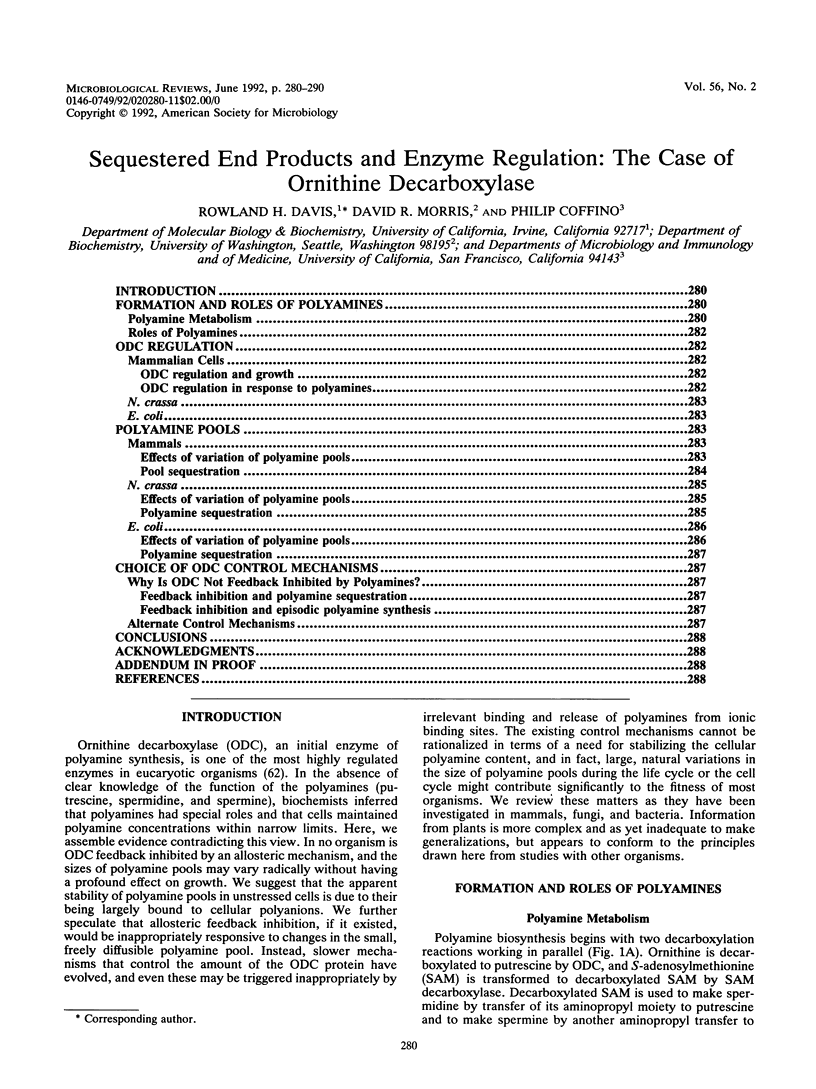
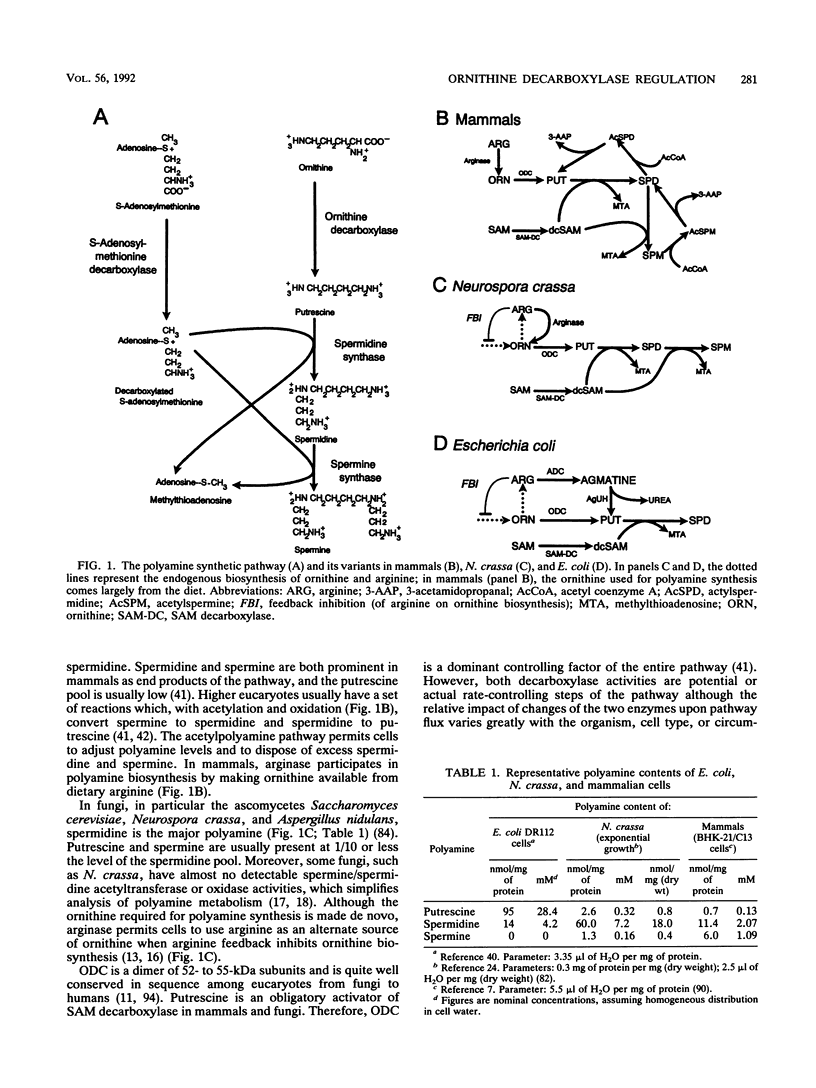
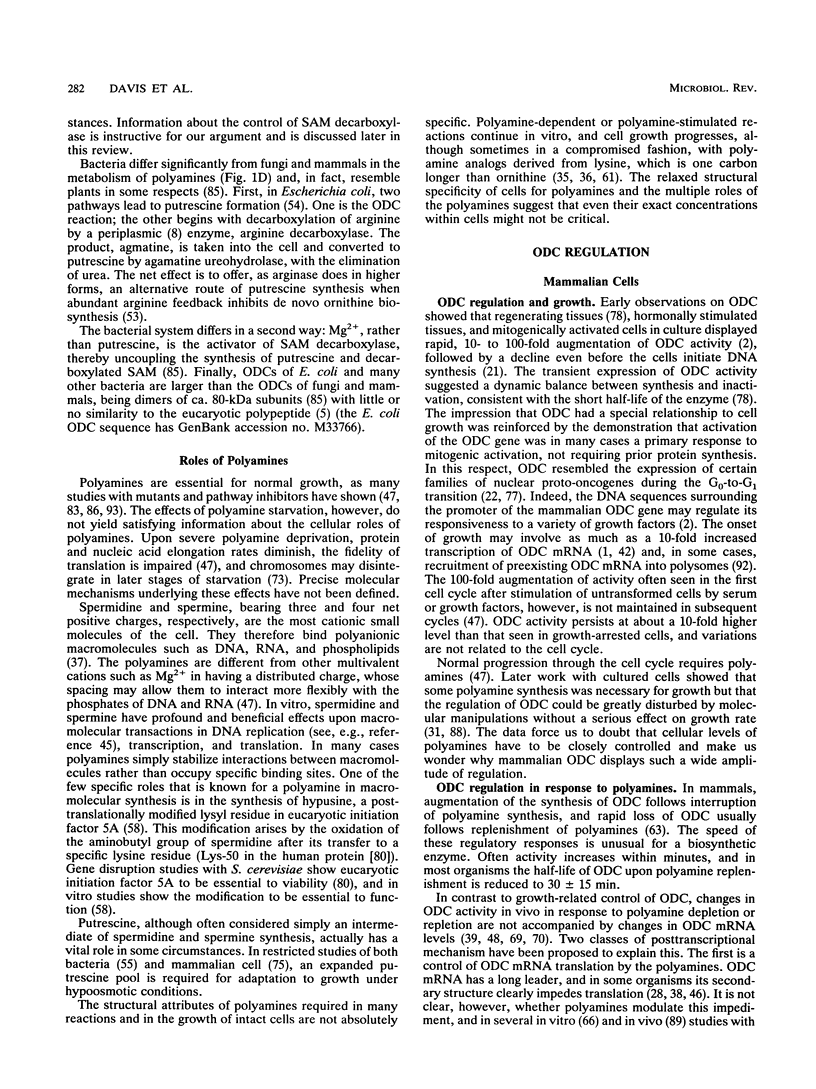
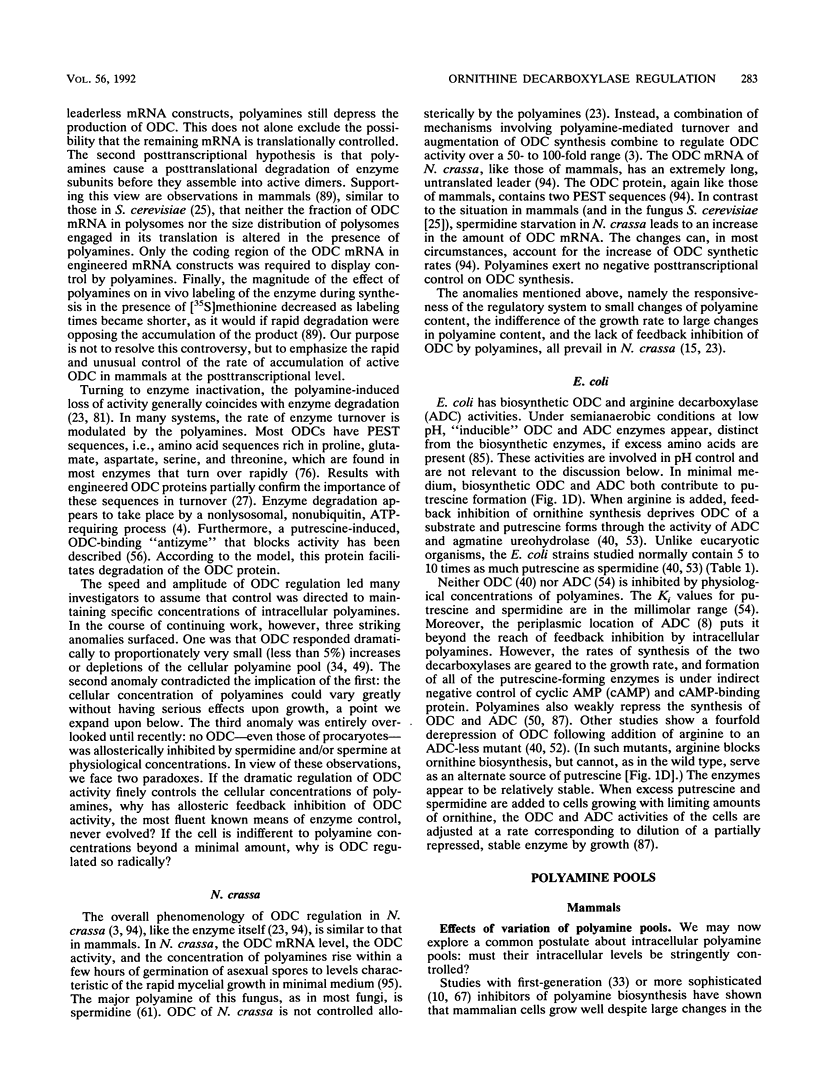
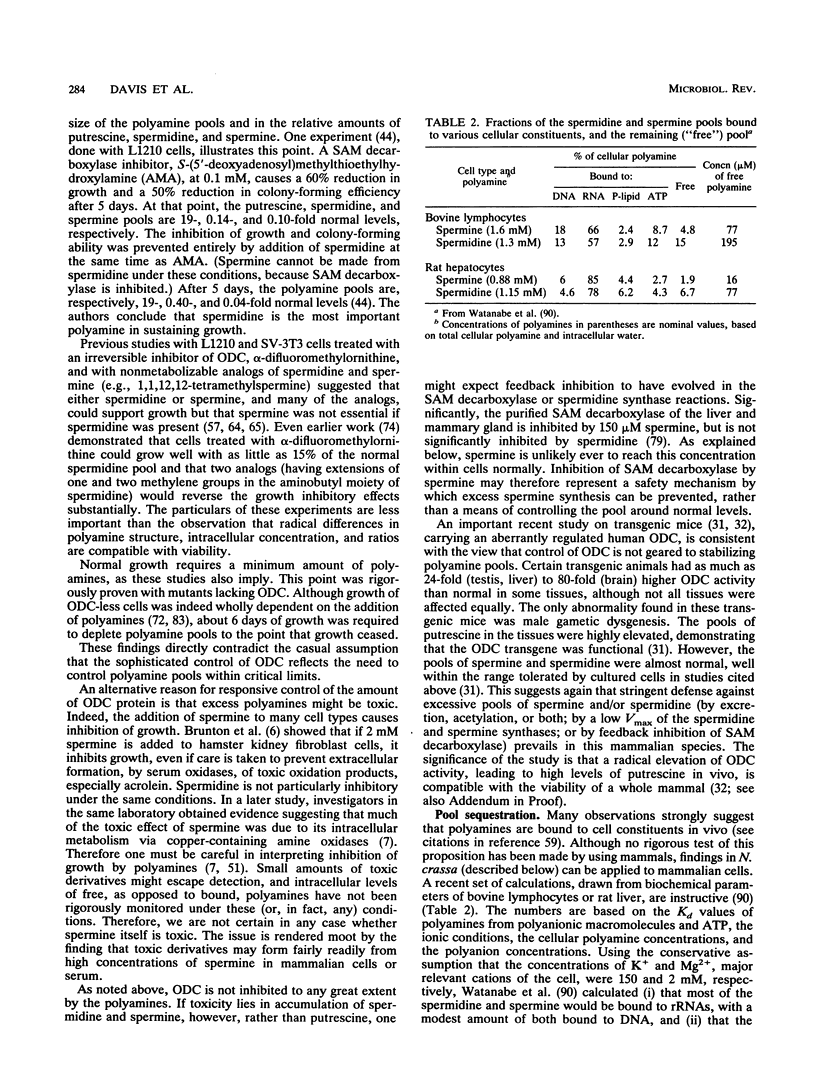
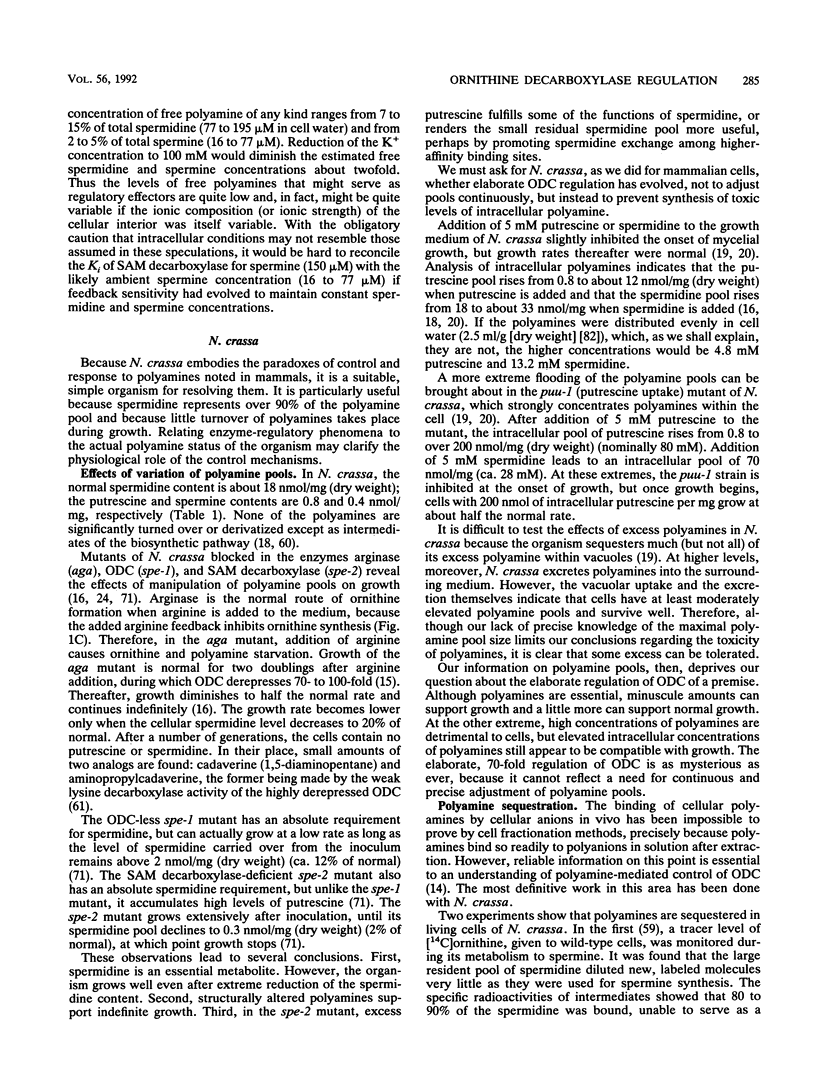



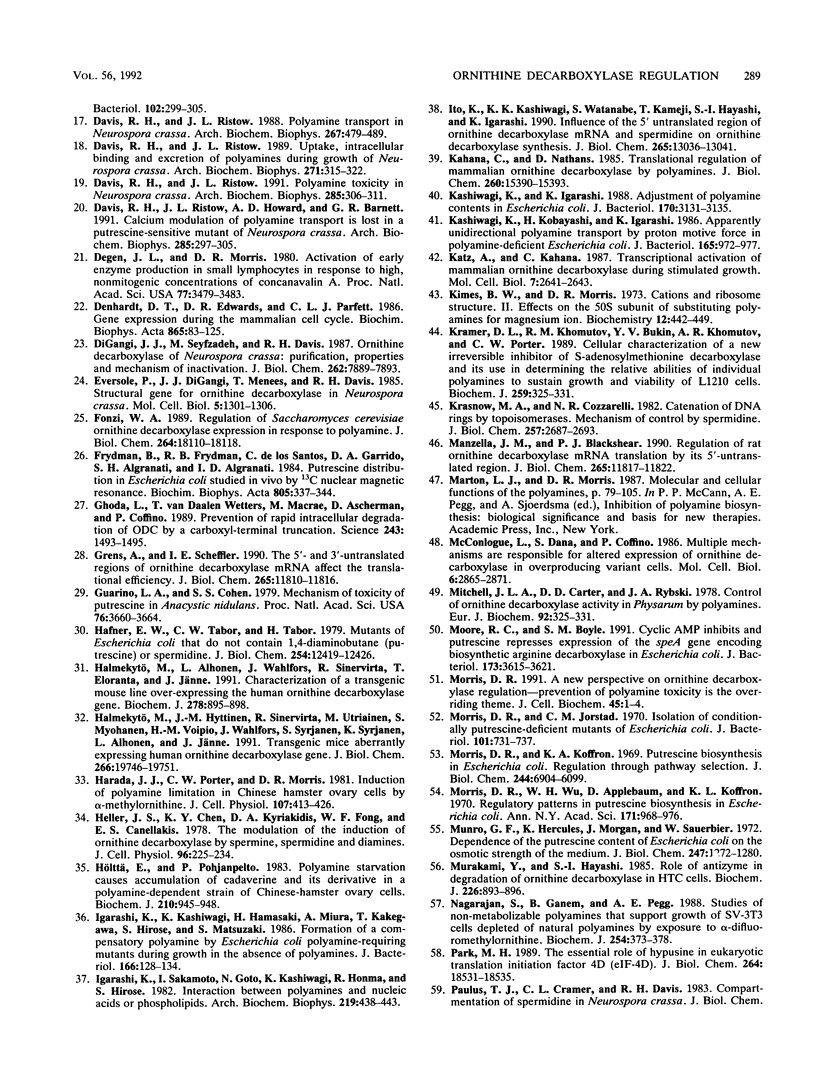

Selected References
These references are in PubMed. This may not be the complete list of references from this article.
- Abrahamsen M. S., Morris D. R. Cell type-specific mechanisms of regulating expression of the ornithine decarboxylase gene after growth stimulation. Mol Cell Biol. 1990 Oct;10(10):5525–5528. doi: 10.1128/mcb.10.10.5525. [DOI] [PMC free article] [PubMed] [Google Scholar]
- Barnett G. R., Seyfzadeh M., Davis R. H. Putrescine and spermidine control degradation and synthesis of ornithine decarboxylase in Neurospora crassa. J Biol Chem. 1988 Jul 15;263(20):10005–10008. [PubMed] [Google Scholar]
- Bercovich Z., Rosenberg-Hasson Y., Ciechanover A., Kahana C. Degradation of ornithine decarboxylase in reticulocyte lysate is ATP-dependent but ubiquitin-independent. J Biol Chem. 1989 Sep 25;264(27):15949–15952. [PubMed] [Google Scholar]
- Brunton V. G., Grant M. H., Wallace H. M. Mechanisms of spermine toxicity in baby-hamster kidney (BHK) cells. The role of amine oxidases and oxidative stress. Biochem J. 1991 Nov 15;280(Pt 1):193–198. doi: 10.1042/bj2800193. [DOI] [PMC free article] [PubMed] [Google Scholar]
- Brunton V. G., Grant M. H., Wallace H. M. Spermine toxicity and glutathione depletion in BHK-21/C13 cells. Biochem Pharmacol. 1990 Oct 15;40(8):1893–1900. doi: 10.1016/0006-2952(90)90371-q. [DOI] [PubMed] [Google Scholar]
- Buch J. K., Boyle S. M. Biosynthetic arginine decarboxylase in Escherichia coli is synthesized as a precursor and located in the cell envelope. J Bacteriol. 1985 Aug;163(2):522–527. doi: 10.1128/jb.163.2.522-527.1985. [DOI] [PMC free article] [PubMed] [Google Scholar]
- Canellakis E. S., Viceps-Madore D., Kyriakidis D. A., Heller J. S. The regulation and function of ornithine decarboxylase and of the polyamines. Curr Top Cell Regul. 1979;15:155–202. [PubMed] [Google Scholar]
- Casero R. A., Jr, Bergeron R. J., Porter C. W. Treatment with alpha-difluoromethylornithine plus a spermidine analog leads to spermine depletion and growth inhibition in cultured L1210 leukemia cells. J Cell Physiol. 1984 Dec;121(3):476–482. doi: 10.1002/jcp.1041210305. [DOI] [PubMed] [Google Scholar]
- Cohen S. S., Morgan S., Streibel E. The polyamine content of the tRNA of E. coli. Proc Natl Acad Sci U S A. 1969 Oct;64(2):669–676. doi: 10.1073/pnas.64.2.669. [DOI] [PMC free article] [PubMed] [Google Scholar]
- Davis R. H. Compartmental and regulatory mechanisms in the arginine pathways of Neurospora crassa and Saccharomyces cerevisiae. Microbiol Rev. 1986 Sep;50(3):280–313. doi: 10.1128/mr.50.3.280-313.1986. [DOI] [PMC free article] [PubMed] [Google Scholar]
- Davis R. H., Krasner G. N., DiGangi J. J., Ristow J. L. Distinct roles of putrescine and spermidine in the regulation of ornithine decarboxylase in Neurospora crassa. Proc Natl Acad Sci U S A. 1985 Jun;82(12):4105–4109. doi: 10.1073/pnas.82.12.4105. [DOI] [PMC free article] [PubMed] [Google Scholar]
- Davis R. H. Management of polyamine pools and the regulation of ornithine decarboxylase. J Cell Biochem. 1990 Dec;44(4):199–205. doi: 10.1002/jcb.240440402. [DOI] [PubMed] [Google Scholar]
- Davis R. H., Ristow J. L., Howard A. D., Barnett G. R. Calcium modulation of polyamine transport is lost in a putrescine-sensitive mutant of Neurospora crassa. Arch Biochem Biophys. 1991 Mar;285(2):297–305. doi: 10.1016/0003-9861(91)90363-n. [DOI] [PubMed] [Google Scholar]
- Davis R. H., Ristow J. L. Polyamine toxicity in Neurospora crassa: protective role of the vacuole. Arch Biochem Biophys. 1991 Mar;285(2):306–311. doi: 10.1016/0003-9861(91)90364-o. [DOI] [PubMed] [Google Scholar]
- Davis R. H., Ristow J. L. Polyamine transport in Neurospora crassa. Arch Biochem Biophys. 1988 Dec;267(2):479–489. doi: 10.1016/0003-9861(88)90054-9. [DOI] [PubMed] [Google Scholar]
- Davis R. H., Ristow J. L. Uptake, intracellular binding, and excretion of polyamines during growth of Neurospora crassa. Arch Biochem Biophys. 1989 Jun;271(2):315–322. doi: 10.1016/0003-9861(89)90281-6. [DOI] [PubMed] [Google Scholar]
- Degen J. L., Morris D. R. Activation of early enzyme production in small lymphocytes in response to high, nonmitogenic concentrations of concanavalin A. Proc Natl Acad Sci U S A. 1980 Jun;77(6):3479–3483. doi: 10.1073/pnas.77.6.3479. [DOI] [PMC free article] [PubMed] [Google Scholar]
- Denhardt D. T., Edwards D. R., Parfett C. L. Gene expression during the mammalian cell cycle. Biochim Biophys Acta. 1986 Oct 28;865(2):83–125. doi: 10.1016/0304-419x(86)90024-7. [DOI] [PubMed] [Google Scholar]
- DiGangi J. J., Seyfzadeh M., Davis R. H. Ornithine decarboxylase from Neurospora crassa. Purification, characterization, and regulation by inactivation. J Biol Chem. 1987 Jun 5;262(16):7889–7893. [PubMed] [Google Scholar]
- Eversole P., DiGangi J. J., Menees T., Davis R. H. Structural gene for ornithine decarboxylase in Neurospora crassa. Mol Cell Biol. 1985 Jun;5(6):1301–1306. doi: 10.1128/mcb.5.6.1301. [DOI] [PMC free article] [PubMed] [Google Scholar]
- Fonzi W. A. Regulation of Saccharomyces cerevisiae ornithine decarboxylase expression in response to polyamine. J Biol Chem. 1989 Oct 25;264(30):18110–18118. [PubMed] [Google Scholar]
- Frydman B., Frydman R. B., De los Santos C., Garrido D. A., Goldemberg S. H., Algranati I. D. Putrescine distribution in Escherichia coli studied in vivo by 13C nuclear magnetic resonance. Biochim Biophys Acta. 1984 Dec 11;805(4):337–344. doi: 10.1016/0167-4889(84)90016-8. [DOI] [PubMed] [Google Scholar]
- Ghoda L., van Daalen Wetters T., Macrae M., Ascherman D., Coffino P. Prevention of rapid intracellular degradation of ODC by a carboxyl-terminal truncation. Science. 1989 Mar 17;243(4897):1493–1495. doi: 10.1126/science.2928784. [DOI] [PubMed] [Google Scholar]
- Grens A., Scheffler I. E. The 5'- and 3'-untranslated regions of ornithine decarboxylase mRNA affect the translational efficiency. J Biol Chem. 1990 Jul 15;265(20):11810–11816. [PubMed] [Google Scholar]
- Guarino L. A., Cohen S. S. Mechanism of toxicity of putrescine in Anacystis nidulans. Proc Natl Acad Sci U S A. 1979 Aug;76(8):3660–3664. doi: 10.1073/pnas.76.8.3660. [DOI] [PMC free article] [PubMed] [Google Scholar]
- Hafner E. W., Tabor C. W., Tabor H. Mutants of Escherichia coli that do not contain 1,4-diaminobutane (putrescine) or spermidine. J Biol Chem. 1979 Dec 25;254(24):12419–12426. [PubMed] [Google Scholar]
- Halmekytö M., Alhonen L., Wahlfors J., Sinervirta R., Eloranta T., Jänne J. Characterization of a transgenic mouse line over-expressing the human ornithine decarboxylase gene. Biochem J. 1991 Sep 15;278(Pt 3):895–898. doi: 10.1042/bj2780895. [DOI] [PMC free article] [PubMed] [Google Scholar]
- Halmekytö M., Hyttinen J. M., Sinervirta R., Utriainen M., Myöhänen S., Voipio H. M., Wahlfors J., Syrjänen S., Syrjänen K., Alhonen L. Transgenic mice aberrantly expressing human ornithine decarboxylase gene. J Biol Chem. 1991 Oct 15;266(29):19746–19751. [PubMed] [Google Scholar]
- Harada J. J., Porter C. W., Morris D. R. Induction of polyamine limitation in Chinese hamster ovary cells by alpha-methylornithine. J Cell Physiol. 1981 Jun;107(3):413–426. doi: 10.1002/jcp.1041070313. [DOI] [PubMed] [Google Scholar]
- Heller J. S., Chen K. Y., Kyriakidis D. A., Fong W. F., Canellakis E. S. The modulation of the induction of ornithine decarboxylase by spermine, spermidine and diamines. J Cell Physiol. 1978 Aug;96(2):225–234. doi: 10.1002/jcp.1040960211. [DOI] [PubMed] [Google Scholar]
- Hölttä E., Pohjanpelto P. Polyamine starvation causes accumulation of cadaverine and its derivatives in a polyamine-dependent strain of Chinese-hamster ovary cells. Biochem J. 1983 Mar 15;210(3):945–948. doi: 10.1042/bj2100945. [DOI] [PMC free article] [PubMed] [Google Scholar]
- Igarashi K., Kashiwagi K., Hamasaki H., Miura A., Kakegawa T., Hirose S., Matsuzaki S. Formation of a compensatory polyamine by Escherichia coli polyamine-requiring mutants during growth in the absence of polyamines. J Bacteriol. 1986 Apr;166(1):128–134. doi: 10.1128/jb.166.1.128-134.1986. [DOI] [PMC free article] [PubMed] [Google Scholar]
- Igarashi K., Sakamoto I., Goto N., Kashiwagi K., Honma R., Hirose S. Interaction between polyamines and nucleic acids or phospholipids. Arch Biochem Biophys. 1982 Dec;219(2):438–443. doi: 10.1016/0003-9861(82)90175-8. [DOI] [PubMed] [Google Scholar]
- Ito K., Kashiwagi K., Watanabe S., Kameji T., Hayashi S., Igarashi K. Influence of the 5'-untranslated region of ornithine decarboxylase mRNA and spermidine on ornithine decarboxylase synthesis. J Biol Chem. 1990 Aug 5;265(22):13036–13041. [PubMed] [Google Scholar]
- Kahana C., Nathans D. Translational regulation of mammalian ornithine decarboxylase by polyamines. J Biol Chem. 1985 Dec 15;260(29):15390–15393. [PubMed] [Google Scholar]
- Kashiwagi K., Igarashi K. Adjustment of polyamine contents in Escherichia coli. J Bacteriol. 1988 Jul;170(7):3131–3135. doi: 10.1128/jb.170.7.3131-3135.1988. [DOI] [PMC free article] [PubMed] [Google Scholar]
- Kashiwagi K., Kobayashi H., Igarashi K. Apparently unidirectional polyamine transport by proton motive force in polyamine-deficient Escherichia coli. J Bacteriol. 1986 Mar;165(3):972–977. doi: 10.1128/jb.165.3.972-977.1986. [DOI] [PMC free article] [PubMed] [Google Scholar]
- Katz A., Kahana C. Transcriptional activation of mammalian ornithine decarboxylase during stimulated growth. Mol Cell Biol. 1987 Jul;7(7):2641–2643. doi: 10.1128/mcb.7.7.2641. [DOI] [PMC free article] [PubMed] [Google Scholar]
- Kimes B. W., Morris D. R. Cations and ribosome structure. II. Effects on the 50S subunit of substituting polyamines for magnesium ion. Biochemistry. 1973 Jan 30;12(3):442–449. doi: 10.1021/bi00727a013. [DOI] [PubMed] [Google Scholar]
- Kramer D. L., Khomutov R. M., Bukin Y. V., Khomutov A. R., Porter C. W. Cellular characterization of a new irreversible inhibitor of S-adenosylmethionine decarboxylase and its use in determining the relative abilities of individual polyamines to sustain growth and viability of L1210 cells. Biochem J. 1989 Apr 15;259(2):325–331. doi: 10.1042/bj2590325. [DOI] [PMC free article] [PubMed] [Google Scholar]
- Krasnow M. A., Cozzarelli N. R. Catenation of DNA rings by topoisomerases. Mechanism of control by spermidine. J Biol Chem. 1982 Mar 10;257(5):2687–2693. [PubMed] [Google Scholar]
- Manzella J. M., Blackshear P. J. Regulation of rat ornithine decarboxylase mRNA translation by its 5'-untranslated region. J Biol Chem. 1990 Jul 15;265(20):11817–11822. [PubMed] [Google Scholar]
- McConlogue L., Dana S. L., Coffino P. Multiple mechanisms are responsible for altered expression of ornithine decarboxylase in overproducing variant cells. Mol Cell Biol. 1986 Aug;6(8):2865–2871. doi: 10.1128/mcb.6.8.2865. [DOI] [PMC free article] [PubMed] [Google Scholar]
- Mitchell J. L., Carter D. D., Rybski J. A. Control of ornithine decarboxylase activity in Physarum by polyamines. Eur J Biochem. 1978 Dec;92(2):325–331. doi: 10.1111/j.1432-1033.1978.tb12751.x. [DOI] [PubMed] [Google Scholar]
- Moore R. C., Boyle S. M. Cyclic AMP inhibits and putrescine represses expression of the speA gene encoding biosynthetic arginine decarboxylase in Escherichia coli. J Bacteriol. 1991 Jun;173(12):3615–3621. doi: 10.1128/jb.173.12.3615-3621.1991. [DOI] [PMC free article] [PubMed] [Google Scholar]
- Morris D. R., Jorstad C. M. Isolation of conditionally putrescine-deficient mutants of Escherichia coli. J Bacteriol. 1970 Mar;101(3):731–737. doi: 10.1128/jb.101.3.731-737.1970. [DOI] [PMC free article] [PubMed] [Google Scholar]
- Morris D. R., Koffron K. L. Putrescine biosynthesis in Escherichia coli. Regulation through pathway selection. J Biol Chem. 1969 Nov 25;244(22):6094–6099. [PubMed] [Google Scholar]
- Munro G. F., Hercules K., Morgan J., Sauerbier W. Dependence of the putrescine content of Escherichia coli on the osmotic strength of the medium. J Biol Chem. 1972 Feb 25;247(4):1272–1280. [PubMed] [Google Scholar]
- Murakami Y., Hayashi S. Role of antizyme in degradation of ornithine decarboxylase in HTC cells. Biochem J. 1985 Mar 15;226(3):893–896. doi: 10.1042/bj2260893. [DOI] [PMC free article] [PubMed] [Google Scholar]
- Nagarajan S., Ganem B., Pegg A. E. Studies of non-metabolizable polyamines that support growth of SV-3T3 cells depleted of natural polyamines by exposure to alpha-difluoromethylornithine. Biochem J. 1988 Sep 1;254(2):373–378. doi: 10.1042/bj2540373. [DOI] [PMC free article] [PubMed] [Google Scholar]
- Park M. H. The essential role of hypusine in eukaryotic translation initiation factor 4D (eIF-4D). Purification of eIF-4D and its precursors and comparison of their activities. J Biol Chem. 1989 Nov 5;264(31):18531–18535. [PubMed] [Google Scholar]
- Paulus T. J., Davis R. H. Regulation of polyamine synthesis in relation to putrescine and spermidine pools in Neurospora crassa. J Bacteriol. 1981 Jan;145(1):14–20. doi: 10.1128/jb.145.1.14-20.1981. [DOI] [PMC free article] [PubMed] [Google Scholar]
- Paulus T. J., Kiyono P., Davis R. H. Polyamine-deficient Neurospora crassa mutants and synthesis of cadaverine. J Bacteriol. 1982 Oct;152(1):291–297. doi: 10.1128/jb.152.1.291-297.1982. [DOI] [PMC free article] [PubMed] [Google Scholar]
- Pegg A. E., Coward J. K. Growth of mammalian cells in the absence of the accumulation of spermine. Biochem Biophys Res Commun. 1985 Nov 27;133(1):82–89. doi: 10.1016/0006-291x(85)91844-3. [DOI] [PubMed] [Google Scholar]
- Pegg A. E., Jones D. B., Secrist J. A., 3rd Effect of inhibitors of S-adenosylmethionine decarboxylase on polyamine content and growth of L1210 cells. Biochemistry. 1988 Mar 8;27(5):1408–1415. doi: 10.1021/bi00405a003. [DOI] [PubMed] [Google Scholar]
- Pegg A. E., Madhubala R., Kameji T., Bergeron R. J. Control of ornithine decarboxylase activity in alpha-difluoromethylornithine-resistant L1210 cells by polyamines and synthetic analogues. J Biol Chem. 1988 Aug 5;263(22):11008–11014. [PubMed] [Google Scholar]
- Pegg A. E. Polyamine metabolism and its importance in neoplastic growth and a target for chemotherapy. Cancer Res. 1988 Feb 15;48(4):759–774. [PubMed] [Google Scholar]
- Pegg A. E. Recent advances in the biochemistry of polyamines in eukaryotes. Biochem J. 1986 Mar 1;234(2):249–262. doi: 10.1042/bj2340249. [DOI] [PMC free article] [PubMed] [Google Scholar]
- Pegg A. E., Wechter R., Poulin R., Woster P. M., Coward J. K. Effect of S-adenosyl-1,12-diamino-3-thio-9-azadodecane, a multisubstrate adduct inhibitor of spermine synthase, on polyamine metabolism in mammalian cells. Biochemistry. 1989 Oct 17;28(21):8446–8453. doi: 10.1021/bi00447a026. [DOI] [PubMed] [Google Scholar]
- Perry J. W., Oka T. Regulation of ornithine decarboxylase in cultured mouse mammary gland by the osmolarity in the cellular environment. Biochim Biophys Acta. 1980 Apr 17;629(1):24–35. doi: 10.1016/0304-4165(80)90261-5. [DOI] [PubMed] [Google Scholar]
- Persson L., Holm I., Heby O. Translational regulation of ornithine decarboxylase by polyamines. FEBS Lett. 1986 Sep 15;205(2):175–178. doi: 10.1016/0014-5793(86)80892-4. [DOI] [PubMed] [Google Scholar]
- Persson L., Oredsson S. M., Anehus S., Heby O. Ornithine decarboxylase inhibitors increase the cellular content of the enzyme: implications for translational regulation. Biochem Biophys Res Commun. 1985 Aug 30;131(1):239–245. doi: 10.1016/0006-291x(85)91794-2. [DOI] [PubMed] [Google Scholar]
- Pitkin J., Davis R. H. The genetics of polyamine synthesis in Neurospora crassa. Arch Biochem Biophys. 1990 May 1;278(2):386–391. doi: 10.1016/0003-9861(90)90275-4. [DOI] [PubMed] [Google Scholar]
- Pohjanpelto P., Hölttä E., Jänne O. A. Mutant strain of Chinese hamster ovary cells with no detectable ornithine decarboxylase activity. Mol Cell Biol. 1985 Jun;5(6):1385–1390. doi: 10.1128/mcb.5.6.1385. [DOI] [PMC free article] [PubMed] [Google Scholar]
- Pohjanpelto P., Knuutila S. Polyamine deprivation causes major chromosome aberrations in a polyamine-dependent Chinese hamster ovary cell line. Exp Cell Res. 1982 Oct;141(2):333–339. doi: 10.1016/0014-4827(82)90221-x. [DOI] [PubMed] [Google Scholar]
- Porter C. W., Bergeron R. J. Spermidine requirement for cell proliferation in eukaryotic cells: structural specificity and quantitation. Science. 1983 Mar 4;219(4588):1083–1085. doi: 10.1126/science.6823570. [DOI] [PubMed] [Google Scholar]
- Poulin R., Wechter R. S., Pegg A. E. An early enlargement of the putrescine pool is required for growth in L1210 mouse leukemia cells under hypoosmotic stress. J Biol Chem. 1991 Apr 5;266(10):6142–6151. [PubMed] [Google Scholar]
- Rogers S., Wells R., Rechsteiner M. Amino acid sequences common to rapidly degraded proteins: the PEST hypothesis. Science. 1986 Oct 17;234(4774):364–368. doi: 10.1126/science.2876518. [DOI] [PubMed] [Google Scholar]
- Rollins B. J., Stiles C. D. Serum-inducible genes. Adv Cancer Res. 1989;53:1–32. doi: 10.1016/s0065-230x(08)60277-8. [DOI] [PubMed] [Google Scholar]
- Russell D., Snyder S. H. Amine synthesis in rapidly growing tissues: ornithine decarboxylase activity in regenerating rat liver, chick embryo, and various tumors. Proc Natl Acad Sci U S A. 1968 Aug;60(4):1420–1427. doi: 10.1073/pnas.60.4.1420. [DOI] [PMC free article] [PubMed] [Google Scholar]
- SLAYMAN C. W., TATUM E. L. POTASSIUM TRANSPORT IN NEUROSPORA. I. INTRACELLULAR SODIUM AND POTASSIUM CONCENTRATIONS, AND CATION REQUIREMENTS FOR GROWTH. Biochim Biophys Acta. 1964 Nov 29;88:578–592. [PubMed] [Google Scholar]
- Sakai T., Hori C., Kano K., Oka T. Purification and characterization of S-adenosyl-L-methionine decarboxylase from mouse mammary gland and liver. Biochemistry. 1979 Dec 11;18(25):5541–5548. doi: 10.1021/bi00592a003. [DOI] [PubMed] [Google Scholar]
- Schnier J., Schwelberger H. G., Smit-McBride Z., Kang H. A., Hershey J. W. Translation initiation factor 5A and its hypusine modification are essential for cell viability in the yeast Saccharomyces cerevisiae. Mol Cell Biol. 1991 Jun;11(6):3105–3114. doi: 10.1128/mcb.11.6.3105. [DOI] [PMC free article] [PubMed] [Google Scholar]
- Seely J. E., Pegg A. E. Changes in mouse kidney ornithine decarboxylase activity are brought about by changes in the amount of enzyme protein as measured by radioimmunoassay. J Biol Chem. 1983 Feb 25;258(4):2496–2500. [PubMed] [Google Scholar]
- Steglich C., Scheffler I. E. An ornithine decarboxylase-deficient mutant of Chinese hamster ovary cells. J Biol Chem. 1982 Apr 25;257(8):4603–4609. [PubMed] [Google Scholar]
- Stevens L., Winther M. D. Spermine, spermidine and putrescine in fungal development. Adv Microb Physiol. 1979;19:63–148. doi: 10.1016/s0065-2911(08)60198-8. [DOI] [PubMed] [Google Scholar]
- Tabor C. W., Tabor H. Polyamines in microorganisms. Microbiol Rev. 1985 Mar;49(1):81–99. doi: 10.1128/mr.49.1.81-99.1985. [DOI] [PMC free article] [PubMed] [Google Scholar]
- Tabor H., Hafner E. W., Tabor C. W. Construction of an Escherichia coli strain unable to synthesize putrescine, spermidine, or cadaverine: characterization of two genes controlling lysine decarboxylase. J Bacteriol. 1980 Dec;144(3):952–956. doi: 10.1128/jb.144.3.952-956.1980. [DOI] [PMC free article] [PubMed] [Google Scholar]
- Tabor H., Tabor C. W. Formation of 1,4-diaminobutane and of spermidine by an ornithine auxotroph of Escherichia coli grown on limiting ornithine or arginine. J Biol Chem. 1969 May 10;244(9):2286–2292. [PubMed] [Google Scholar]
- Watanabe S., Kusama-Eguchi K., Kobayashi H., Igarashi K. Estimation of polyamine binding to macromolecules and ATP in bovine lymphocytes and rat liver. J Biol Chem. 1991 Nov 5;266(31):20803–20809. [PubMed] [Google Scholar]
- Weiss R. L., Morris D. R. Cations and ribosome structure. I. Effects on the 30S subunit of substituting polyamines for magnesium ion. Biochemistry. 1973 Jan 30;12(3):435–441. doi: 10.1021/bi00727a012. [DOI] [PubMed] [Google Scholar]
- White M. W., Kameji T., Pegg A. E., Morris D. R. Increased efficiency of translation of ornithine decarboxylase mRNA in mitogen-activated lymphocytes. Eur J Biochem. 1987 Dec 30;170(1-2):87–92. doi: 10.1111/j.1432-1033.1987.tb13670.x. [DOI] [PubMed] [Google Scholar]
- Whitney P. A., Morris D. R. Polyamine auxotrophs of Saccharomyces cerevisiae. J Bacteriol. 1978 Apr;134(1):214–220. doi: 10.1128/jb.134.1.214-220.1978. [DOI] [PMC free article] [PubMed] [Google Scholar]
- Williams L. J., Barnett G. R., Ristow J. L., Pitkin J., Perriere M., Davis R. H. Ornithine decarboxylase gene of Neurospora crassa: isolation, sequence, and polyamine-mediated regulation of its mRNA. Mol Cell Biol. 1992 Jan;12(1):347–359. doi: 10.1128/mcb.12.1.347. [DOI] [PMC free article] [PubMed] [Google Scholar]
- van Daalen Wetters T., Brabant M., Coffino P. Regulation of mouse ornithine decarboxylase activity by cell growth, serum and tetradecanoyl phorbol acetate is governed primarily by sequences within the coding region of the gene. Nucleic Acids Res. 1989 Dec 11;17(23):9843–9860. doi: 10.1093/nar/17.23.9843. [DOI] [PMC free article] [PubMed] [Google Scholar]
- van Daalen Wetters T., Macrae M., Brabant M., Sittler A., Coffino P. Polyamine-mediated regulation of mouse ornithine decarboxylase is posttranslational. Mol Cell Biol. 1989 Dec;9(12):5484–5490. doi: 10.1128/mcb.9.12.5484. [DOI] [PMC free article] [PubMed] [Google Scholar]


